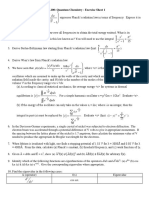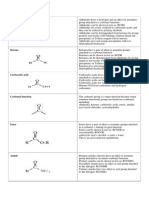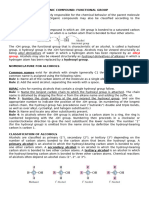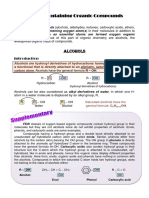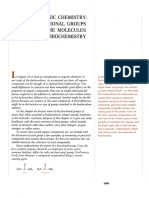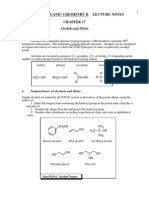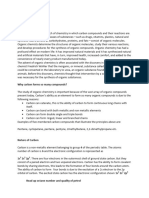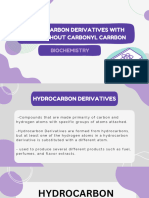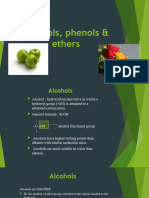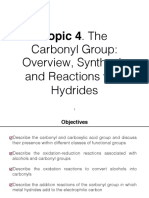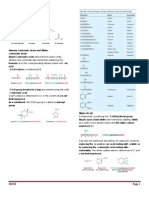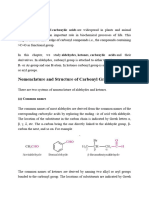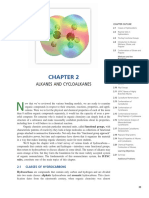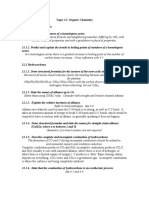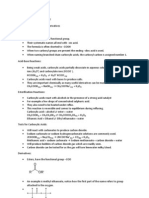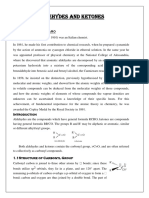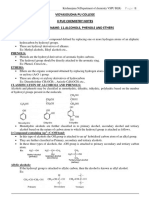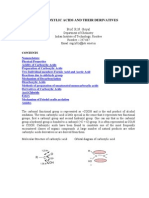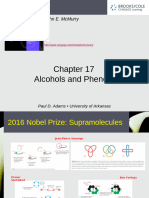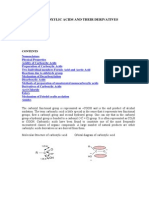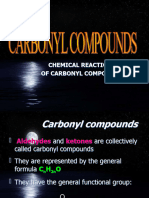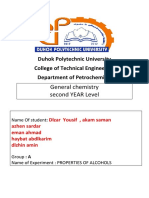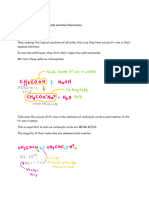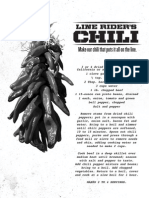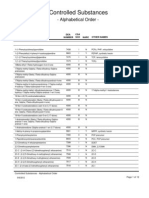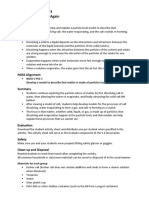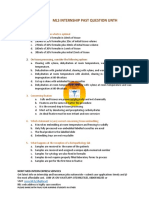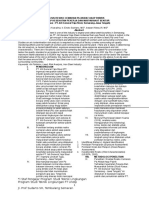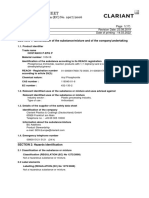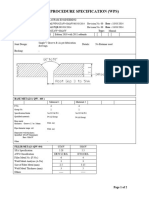Organic Functional Groups
Organic Functional Groups
Uploaded by
Scientology1Copyright:
Available Formats
Organic Functional Groups
Organic Functional Groups
Uploaded by
Scientology1Copyright
Available Formats
Share this document
Did you find this document useful?
Is this content inappropriate?
Copyright:
Available Formats
Organic Functional Groups
Organic Functional Groups
Uploaded by
Scientology1Copyright:
Available Formats
Organic Functional Groups:
Aldehydes, ketones, primary alcohols, etc.
Organic chemistry is dominated by the "functional group approach", where organic molecules are deemed to be constructed from:
l
An inert hydrocarbon skeleton onto which functional groups (FGs) are attached or superimposed.
The functional group approach "works" because the properties and reaction chemistry of a particular functional group (FG) can be remarkably independent of environment. Therefore, it is only necessary to know about the chemistry of a few generic functions in order to predict the chemical behaviour of thousands of real organic chemicals. Organic molecules are also named using the functional group approach:
2-hexanone 2-hexanol 2-chlorohexane
The rule is that functions assume their distinct identity when separated by CH2 groups. Thus, the carbonyl, C=O, and hydroxy, OH, of a carboxylic acid, RCOOH, are part of a single function and are NOT "alcohol-plus-ketone":
A Couple of Words About The Functional Group Approach The functional group approach is 100% empirical in that it is determined by experiment and experience, and not by theory (unlike VSEPR, for example.) A multifunctional entity like the drug molecule morphine has several functional groups and chiral centres:
Professional chemists consider large multifunctional organic molecules in terms of 'substructures' rather than functional groups. Ring systems, for example, are better considered as substructures, although the dividing line can be fuzzy...
http://www.chemistry-drills.com/functional-groups.php?q=simple
Page 1 / 8
What You Need To Know To be proficient in organic chemistry at university entrance level [ie, American AP, British ALevel or French Baccalaureate] exam systems, in other words be able to: name organic molecules predict solubility in different types of solvent predict chemical reactivity predict spectra it is absolutely essential to be able to recognise the 30 or so functions listed below:
Alkane
Alkyl, and occasionally aryl (aromatic) functions are represented by the RMethyl: CH3 Ethyl: CH3CH2 Propyl: CH3CH2CH2 Isopropyl: (CH3)2CH Phenyl: C6H5 etc.
Alkyl halide
Alkyl halides [haloalkanes] consist of an alkyl group attached to a halogen: F, Cl, Br, I. Chloro, bromo and iodo alkyl halides are often susceptible to elimination and/or nucleophilic substitution reactions.
Primary alcohol
Primary alcohols have an -OH function attached to an R-CH2- group. Primary alcohols can be oxidised to aldehydes and on to carboxylic acids. (It can be difficult to stop the oxidation at the aldehyde stage.) Primary alcohols can be shown in text as: RCH2OH
Secondary alcohol
Secondary alcohols have an -OH function attached to a R2CH- group. Secondary alcohols can be oxidised to ketones. Secondary alcohols can be shown in text as: R2CHOH
Tertiary alcohol
Tertiary alcohols have an -OH function attached to a R3C- group.
http://www.chemistry-drills.com/functional-groups.php?q=simple
Page 2 / 8
Tertiary alcohols are resistant to oxidation with acidified potassium dichromate(VI), K. Tertiary alcohols can be shown in text as: R3COH
Aldehyde
Aldehydes have a hydrogen and an alkyl (or aromatic) group attached to a carbonyl function. Aldehydes can be shown in text as: RCHO Aldehydes are easily oxidised to carboxylic acids, and they can be reduced to primary alcohols. Aldehydes can be distinguished from ketones by giving positive test results with Fehlings solution (brick red precipitate) or Tollens reagent (silver mirror). Aldehydes give red-orange precipitates with 2,4dinitrophenyl hydrazine.
Ketone
Ketones have a pair of alkyl or aromatic groups attached to a carbonyl function. Ketones can be shown in text as: RCOR Ketones can be distinguished from aldehydes by givingnegativetestresultswithFehlingssolution (brick red precipitate) or Tollens reagent (silver mirror). Ketones give red-orange precipitates with 2,4dinitrophenyl hydrazine.
Carboxylic acid
Carboxylic acids have an alkyl or aromatic groups attached to a hydroxy-carbonyl function. Carboxylic acids can be shown in text as: RCOOH Carboxylic acids are weak Bronsted acids and they liberate CO2 from carbonates and hydrogen carbonates.
Carbonyl function
The carbonyl group is a super function because many common functional groups are based on a carbonyl, including: aldehydes, ketones, carboxylic acids, esters, amides, acyl (acid) chlorides, acid anhydrides
Ester
Esters have a pair of alkyl or aromatic groups attached to a carbonyl + linking oxygen function. Esters can be shown in text as: RCOOR or (occasionally) ROCOR. carboxylic acid + alcohol -> ester + water This is an acid catalysed equilibrium.
http://www.chemistry-drills.com/functional-groups.php?q=simple
Page 3 / 8
Amide
Primary amides (shown) have an alkyl or aromatic group attached to an amino-carbonyl function. Primary amides can be shown in text as: RCONH2 Secondary amides have an alkyl or aryl group attached to the nitrogen: RCONHR Tertiary amides have two alkyl or aryl group attached to the nitrogen: RCONR2
Primary amine
Primary amines have an alkyl or aromatic group and two hydrogens attached to a nitrogen atom. Primary amines can be shown in text as: RNH2 Primary amines are basic functions that can be protonated to the corresponding ammonium ion. Primary amines are also nucleophilic.
Secondary amine
Secondary amines have a pair of alkyl or aromatic groups, and a hydrogen, attached to a nitrogen atom. Secondary amines can be shown in text as: R2NH Secondary amines are basic functions that can be protonated to the corresponding ammonium ion. Secondary amines are also nucleophilic.
Tertiary amine
Tertiary amines have three alkyl or aromatic groups attached to a nitrogen atom. Tertiary amines can be shown in text as: R3N Tertiary amines are basic functions that can be protonated to the corresponding ammonium ion. Tertiary amines are also nucleophilic.
Acid chloride
Acid chlorides, or acyl chlorides, have an alkyl (or aromatic) group attached to a carbonyl function plus a labile (easily displaced) chlorine. Acid chlorides highly reactive entities are highly susceptible to attack by nucleophiles. Acid chlorides can be shown in text as: ROCl
Acid anhydride
Acid anhydrides are formed when water is removed from a carboxylic acid, hence the name. Acid anhydrides can be shown in text as: (RO)2O
http://www.chemistry-drills.com/functional-groups.php?q=simple
Page 4 / 8
Nitrile
Nitriles (or organo cyanides) have an alkyl (or aromatic) group attached to a carbon-triple-bondnitrogen function. Nitriles can be shown in text as: RCN Note that there is a nomenclature issue with nitriles/cyanides. If a compound is named as the nitrile then the nitrile carbon is counted and included, but when the compound is named as the cyanide it is not. For example: CH3CH2CN is called propane nitrile or ethyl cyanide (cyanoethane).
Carboxylate ion or salt
Carboxylate ions are the conjugate bases of carboxylic acids, ie. the deprotonated carboxylic acid. Carboxylate ions can be shown in text as: RCOO When the counter ion is included, the salt is being shown. Salts can be shown in text as: RCOONa
Ammonium ion
Ammonium ions have a total of four alkyl and/or hydrogen functions attached to a nitrogen atom. [NH4]+ [RNH3]+ [R2NH2]+ [R3NH]+ [R4N]+ Quaternary ammonium ions are not proton donors, but the others are weak Bronsted acids (pKa about 10).
Amino acid
Amino acids, strictly alpha-amino acids, have carboxylic acid, amino function and a hydrogen attached to a the same carbon atom. There are 20 naturally occurring amino acids. All except glycine (R = H) are chiral and only the L enantiomer is found in nature. Amino acids can be shown in text as: R-CH(NH2) COOH
Alkene
Alkenes consist of a C=C double bond function. Alkenes can be shown in text as: Mono substituted: RCH=CH2 1,1-disubstituted: R2C=CH2 1,2-disubstituted: RCH=CHR Alkenes are planar and there is no rotation about the C=C bond. Alkenes are electron rich reactive centres and are susceptible to electrophilic addition.
trans-Alkene
trans-alkenes are 1,2-disubstituted functions with the two R, X or other groups on opposite sides of the C=C function.
http://www.chemistry-drills.com/functional-groups.php?q=simple
Page 5 / 8
Due to the non-rotation of the C=C bond, cis and trans geometric isomers are not [thermally] Interconverted.
cis-Alkene
cis-Alkenes are 1,2-disubstituted functions with the two R, X or other groups on the same side of the C=C function. Due to the non-rotation of the C=C bond, cis and trans geometric isomers are not [thermally] Interconvertion.
Ether
Ethers have a pair of alkyl or aromatic groups attached to a linking oxygen atom. Ethers can be shown in text as: ROR Ethers are surprisingly unreactive and are very useful as solvents for many many (but not all) classes of reaction.
Alkoxide ion
Alkoxide ions an alkyl group attached to an oxyanion. Alkoxide ions can be shown in text as: RO Sodium alkoxides, RONa, are slightly stronger bases than water and so cannot be prepared in water. Instead they are prepared by adding sodium to the dry alcohol.
Hydroxynitrile
Hydroxynitriles (also called cyanohydrins) are formed when hydrogen cyanide, H+ CN, adds across the carbonyl function of an aldehyde or ketone.
Primary carbocation
Primary carbocations have a single alkyl function attached to a carbon centre with a formal positive charge. Carbocations - also and more correctly called carbenium ions - are important reactive intermediates implicated in electrophilic addition reactions and electrophilic aromatic substitution reactions. Stability: primary << secondary << tertiary
http://www.chemistry-drills.com/functional-groups.php?q=simple
Page 6 / 8
Secondary carbocation
Secondary carbocations have a pair of alkyl functions attached to a carbon centre with a formal positive charge. Carbocations - also and more correctly called carbenium ions - are important reactive intermediates implicated in electrophilic addition reactions and electrophilic aromatic substitution reactions. Stability: primary << secondary << tertiary
Tertiary carbocation
Tertiary carbocations have three alkyl functions attached to a carbon centre with a formal positive charge. Carbocations - also and more correctly called carbenium ions - are important reactive intermediates implicated in electrophilic addition reactions and electrophilic aromatic substitution reactions. Stability: primary << secondary << tertiary
Acyl cation
Acyl cations have an alkyl (or aromatic) group attached to a carbonyl function with a formal positive charge. Acyl cations are important reactive intermediates and are implicated in electrophilic addition reactions and electrophilic aromatic substitution reactions. Acyl cations are commonly formed from the corresponding acyl/acid chloride plus aluminium chloride.
Polymer
Polymers consist of small monomer molecules that have reacted together so as to form a large covalently bonded structure. There are two general types of polymerisation: addition and condensation. Linear chain polymers are generally thermoplastic, while three dimensional network polymers are not.
Diol or polyol
Diols and polyols are alcohols with two or more -OH functions. Diols and polyols are very soluble in water. They are used as high temperature polar solvents.
Mark R. Leach 1999-2009
Queries, Suggestions, Bugs, Errors, Typos...
If you have any: Queries
http://www.chemistry-drills.com/functional-groups.php?q=simple
Page 7 / 8
Comments Suggestions Suggestions for links Bug, typo or grammatical error reports about this page, please contact Mark R. Leach, the author, using mrl@meta-synthesis.com This free, open access web site is an ongoing project and your input is appreciated.
http://www.chemistry-drills.com/functional-groups.php?q=simple
Page 8 / 8
You might also like
- GHB Synthesis 1Document8 pagesGHB Synthesis 1Scientology183% (6)
- CHM 121 Lecture NoteDocument13 pagesCHM 121 Lecture NoteOyedotun TundeNo ratings yet
- Schaum's Easy Outline of Organic Chemistry, Second EditionFrom EverandSchaum's Easy Outline of Organic Chemistry, Second EditionRating: 3.5 out of 5 stars3.5/5 (2)
- BZP SynthesisDocument3 pagesBZP SynthesisScientology1No ratings yet
- Kurlova I Nachinaem Chitat Po-Russki 33Document112 pagesKurlova I Nachinaem Chitat Po-Russki 33Metanet M-ovaNo ratings yet
- 03.the New Penguin Russian CourseDocument528 pages03.the New Penguin Russian CourseTanya Stepanova100% (2)
- Project 6 - Ethylene Oxide PDFDocument13 pagesProject 6 - Ethylene Oxide PDFStephanie Hawkins50% (2)
- CML100 - Quantum Sheet 1 PDFDocument2 pagesCML100 - Quantum Sheet 1 PDFDivyansh GuptaNo ratings yet
- AldehydeDocument3 pagesAldehydeSem.Jb TanNo ratings yet
- Functional Groups: Organic Chemistry EssentialsDocument8 pagesFunctional Groups: Organic Chemistry EssentialsJeremiah Paul Gotia HumiwatNo ratings yet
- Organic Compound Functional Group HandoutsDocument3 pagesOrganic Compound Functional Group HandoutsSalli MomoyNo ratings yet
- Chemistry: Organic CompoundsDocument22 pagesChemistry: Organic CompoundsjulianaNo ratings yet
- Alcohols Phenols and Ether by AarkumarDocument0 pagesAlcohols Phenols and Ether by AarkumarNikhil Surya MukhiNo ratings yet
- Experiment 4Document11 pagesExperiment 4kittyluna023No ratings yet
- Oxygen Containing Organic CompoundsDocument9 pagesOxygen Containing Organic CompoundsmNo ratings yet
- CH 20Document8 pagesCH 20adafgsdfgNo ratings yet
- Alcoholes 3Document47 pagesAlcoholes 3Дана ЧилибаеваNo ratings yet
- Organic Chemistry Functional Groups and The Molecules of BiochemistryDocument34 pagesOrganic Chemistry Functional Groups and The Molecules of BiochemistryAdriana RodriguezNo ratings yet
- Different Functional Groups and Their Uses in Organic Compounds 2Document25 pagesDifferent Functional Groups and Their Uses in Organic Compounds 2Belaro JennyNo ratings yet
- Functional G Chem 15th FebDocument64 pagesFunctional G Chem 15th FebAndrew GordonNo ratings yet
- Alcohols, Ethers and PhenolsDocument45 pagesAlcohols, Ethers and Phenolsshivam08No ratings yet
- CH 17Document18 pagesCH 17MirjanaNo ratings yet
- I. Carboxylic Acids NotesDocument6 pagesI. Carboxylic Acids Noteskipkemoingetich1805No ratings yet
- Alcohol, Phenol and EtherDocument21 pagesAlcohol, Phenol and EtherAditya NandaNo ratings yet
- Organic ChemistryDocument17 pagesOrganic ChemistryAbdifatah AbdirahmanNo ratings yet
- pdf_20240129_141231_0000 (1)Document34 pagespdf_20240129_141231_0000 (1)Phoebie Cate HernandezNo ratings yet
- Classification Test For HydroxylDocument2 pagesClassification Test For HydroxylJ.c. RimorinNo ratings yet
- General Chemistry I M2W4Document5 pagesGeneral Chemistry I M2W4Warley JabelNo ratings yet
- Chem Lec Homework 020714Document18 pagesChem Lec Homework 020714Almarie PasaoaNo ratings yet
- 11-ORGANIC-CHEMISTRY ImpDocument5 pages11-ORGANIC-CHEMISTRY ImpSandeep PlaysNo ratings yet
- Alcohols, Phenols, Ethers and ThiolsDocument22 pagesAlcohols, Phenols, Ethers and ThiolsJenan Usman JalilNo ratings yet
- Alcohols, Phenols & EthersDocument27 pagesAlcohols, Phenols & Ethershgp9ms5gjcNo ratings yet
- 04 The Carbonyl Group (2313Spr2018) Skeletal NotesDocument56 pages04 The Carbonyl Group (2313Spr2018) Skeletal NotesDiana ToroNo ratings yet
- Carboxylic AcidsDocument5 pagesCarboxylic AcidsMarkyNo ratings yet
- ALCHOL PHENOL ETHERDocument18 pagesALCHOL PHENOL ETHERl8627352No ratings yet
- Revised Organic ChemistryDocument90 pagesRevised Organic ChemistryMinh TieuNo ratings yet
- Class 12 Aldehydes, Ketones and Carboxylic AcidsDocument20 pagesClass 12 Aldehydes, Ketones and Carboxylic Acidsst06082005No ratings yet
- Laporan IGF AlimDocument11 pagesLaporan IGF Alimppg.risdaniar99130No ratings yet
- Theoretical Framework Functional GroupDocument8 pagesTheoretical Framework Functional GroupScribdTranslationsNo ratings yet
- Lecture. 13,14,15 PDFDocument45 pagesLecture. 13,14,15 PDFsarah100% (1)
- Chapter 2Document35 pagesChapter 2Ms PNo ratings yet
- ALCOHOLSDocument15 pagesALCOHOLSiammathetaNo ratings yet
- 10 Haloalkanes and Haloarenes PPT-1Document107 pages10 Haloalkanes and Haloarenes PPT-1Dhruv Jain100% (1)
- Alcohols and PhenolsDocument72 pagesAlcohols and PhenolsChandra ReddyNo ratings yet
- SCH 106 Lecture IV 2024Document18 pagesSCH 106 Lecture IV 2024okumuenock000No ratings yet
- Topic 11: Organic Chemistry 11.1 Homologous SeriesDocument8 pagesTopic 11: Organic Chemistry 11.1 Homologous Seriesbn100% (1)
- Organic 2,3Document22 pagesOrganic 2,3rachit agarwalNo ratings yet
- F334 - What's in A Medicine?Document11 pagesF334 - What's in A Medicine?Becky Tenney100% (1)
- Jee-Aldehyde Ketone & Carboxylic Acid Chem XiiDocument72 pagesJee-Aldehyde Ketone & Carboxylic Acid Chem Xiiswastik aroraNo ratings yet
- Chapter-11 Alcohols, Phenols and Ethers-NotesDocument16 pagesChapter-11 Alcohols, Phenols and Ethers-NotesAdithya kumar JhaNo ratings yet
- PDF Carboxylic AcidsDocument45 pagesPDF Carboxylic AcidsRegina Maree Bermudez100% (1)
- Chapter 17Document64 pagesChapter 17님킹디No ratings yet
- Chapter 23 Functional GroupsDocument81 pagesChapter 23 Functional GroupsYudi PermanaNo ratings yet
- Catboxylic Acids and Their DerivativesDocument45 pagesCatboxylic Acids and Their DerivativesAnil Kumar VermaNo ratings yet
- Alkanes 1-1Document22 pagesAlkanes 1-1Benjamen FolarinNo ratings yet
- Carbonyl CompoundsDocument25 pagesCarbonyl CompoundsLyana TaylorNo ratings yet
- BPOCchapter18 PDFDocument74 pagesBPOCchapter18 PDFShivani DamorNo ratings yet
- General Chemistry Second YEAR LevelDocument4 pagesGeneral Chemistry Second YEAR LevelMaran Kachocha AlkldaneNo ratings yet
- Chemistry A2 Chapter 26 Carboxylic Acids and Thier DerivativesDocument19 pagesChemistry A2 Chapter 26 Carboxylic Acids and Thier Derivativesubaidejaz54No ratings yet
- CHEM 109-Chepter 6Document28 pagesCHEM 109-Chepter 6naifalfarraj3No ratings yet
- Lesson 3Document35 pagesLesson 3Pablo Perez lopezNo ratings yet
- Bonding in Carbonyl CompoundsDocument11 pagesBonding in Carbonyl CompoundsRohini SelvarajahNo ratings yet
- CHM 171 Lecture Note Nov 2021Document10 pagesCHM 171 Lecture Note Nov 2021julietjustina14No ratings yet
- Practice Makes Perfect in Chemistry: Acids, Bases, and Salts with AnswersFrom EverandPractice Makes Perfect in Chemistry: Acids, Bases, and Salts with AnswersNo ratings yet
- Practice Makes Perfect in Chemistry: Compounds, Reactions and Moles with AnswersFrom EverandPractice Makes Perfect in Chemistry: Compounds, Reactions and Moles with AnswersRating: 3 out of 5 stars3/5 (2)
- Wof Loc Red Gap Chili 9j434Document1 pageWof Loc Red Gap Chili 9j434Scientology1No ratings yet
- Controlled Substances Alpha. Order Sept. 2012Document12 pagesControlled Substances Alpha. Order Sept. 2012Scientology1No ratings yet
- Hacking NotesDocument1 pageHacking NotesScientology1No ratings yet
- Article 1498807135Document4 pagesArticle 1498807135Parshuram ShendgeNo ratings yet
- Standard State and Enthalpy of Formation, Gibbs Free Energy of Formation, Entropy and Heat CapacityDocument10 pagesStandard State and Enthalpy of Formation, Gibbs Free Energy of Formation, Entropy and Heat CapacityDominic LibradillaNo ratings yet
- Solution, Solubility & Gas LawsDocument5 pagesSolution, Solubility & Gas LawsSabbir HossainNo ratings yet
- Water and Its Treatment-5,6Document3 pagesWater and Its Treatment-5,6Tushar Sharma100% (1)
- As BiologyDocument127 pagesAs BiologyRob Gomez100% (7)
- Coke Oven and By-ProductsDocument15 pagesCoke Oven and By-ProductsRitik ChaturvediNo ratings yet
- E6010Document3 pagesE6010Anonymous oUoJ4A8xNo ratings yet
- Design of Leaf SpringsDocument27 pagesDesign of Leaf Springsmic50% (2)
- 5 Grade - Lesson 1.3 Dissolving and Back Again: ObjectiveDocument4 pages5 Grade - Lesson 1.3 Dissolving and Back Again: ObjectiveManushka ThomasNo ratings yet
- 5 Rubbing Compound 3MDocument12 pages5 Rubbing Compound 3MSharath Gowda VGNo ratings yet
- Chemical Hazards in RefineryDocument11 pagesChemical Hazards in RefineryRuqiyya Israfilova100% (1)
- Paraloid - k-175 Full DetailsDocument14 pagesParaloid - k-175 Full DetailsVarathasankar ArumugamNo ratings yet
- MSDS Dynamic DescalerDocument4 pagesMSDS Dynamic DescalerEurotech Tra TranNo ratings yet
- Unth Past QuestionDocument4 pagesUnth Past QuestionOgbuefi PascalNo ratings yet
- Cemtec Bitumen Foundation Coating (WB) MSDSDocument4 pagesCemtec Bitumen Foundation Coating (WB) MSDSAbu Bakar ChandNo ratings yet
- Ess 312 Lab 1 ReviewDocument3 pagesEss 312 Lab 1 Reviewlevi_santosNo ratings yet
- GaInP Nanowire Arrays For Color Conversion ApplicationsDocument12 pagesGaInP Nanowire Arrays For Color Conversion Applications18maxwell61No ratings yet
- Jurnal Ta Herti Ayu Yusvalina L2J008033Document9 pagesJurnal Ta Herti Ayu Yusvalina L2J008033sriNo ratings yet
- Brochure - MBR 20 - 80 - HMIDocument2 pagesBrochure - MBR 20 - 80 - HMIkoen irawanNo ratings yet
- ASTM B240 - Zinc and Zinc-Aluminum (ZA) AlloysDocument4 pagesASTM B240 - Zinc and Zinc-Aluminum (ZA) AlloysShawn Deol100% (1)
- Radiology: Historical PerspectiveDocument4 pagesRadiology: Historical PerspectiveJeya Plays YTNo ratings yet
- Question Bank-Physical-Units 4& 5Document14 pagesQuestion Bank-Physical-Units 4& 5SSC ChemistryNo ratings yet
- Clariant SDS HOSTANOX P-EPQ P European Community EnglishDocument17 pagesClariant SDS HOSTANOX P-EPQ P European Community EnglishMuhammad Fahmi AzmiNo ratings yet
- Annex Form J2 D1.1 D1.1M 2020Document3 pagesAnnex Form J2 D1.1 D1.1M 2020Wegig WijanaNo ratings yet
- WPS 03 2014Document2 pagesWPS 03 2014vinuNo ratings yet
- Ettl Scopeof Accri 2021-23Document12 pagesEttl Scopeof Accri 2021-23Prabir KumarNo ratings yet
- AN 10492 GC MS Whiskies AN10492 ENDocument9 pagesAN 10492 GC MS Whiskies AN10492 ENjbsNo ratings yet
- Stock Philips, 12 September 2023Document5 pagesStock Philips, 12 September 2023desakwayanNo ratings yet







